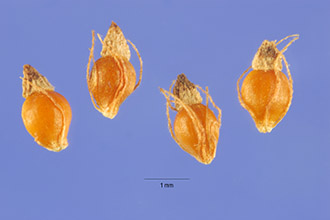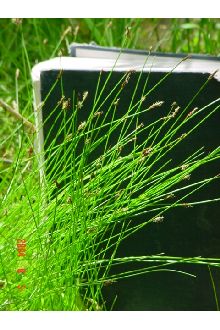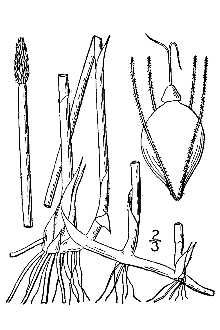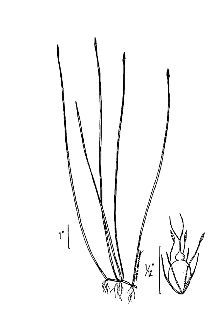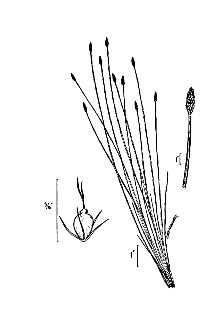Common Spikerush
Scientific Name: Eleocharis palustris (L.) Roem. & Schult.
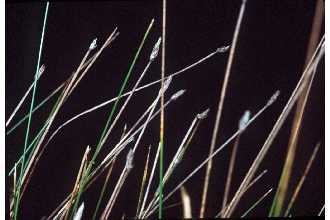
| General Information | |
|---|---|
| Usda Symbol | ELPA3 |
| Group | Monocot |
| Life Cycle | Perennial |
| Growth Habits | Graminoid |
| Native Locations | ELPA3 |
Plant Guide
Alternate Names
Eleocharis macrostachya, common spikerush
Uses
Wildlife and Livestock: Creeping spikerush has a moderately high protein content in the spring and good digestibility. The tops are heavily grazed by both livestock and big game animals, especially after the seeds have ripened. It produces nesting cover for waterfowl and ducks eat the seeds and geese graze the shoots. Conservation Uses: This species has utility for erosion control, constructed wetland system applications, wildlife food and cover, wetland creation and restoration, and for increasing plant diversity in wetland and riparian communities. Its dense root mass makes this species an excellent choice for soil stabilization in riparian and wetland sites. The rhizomes also form a matrix for many beneficial bacteria making this plant an excellent choice for wastewater treatment.
Status
Please consult the PLANTS Web site and your State Department of Natural Resources for this plant’s current status (e.g. threatened or endangered species, state noxious status, and wetland indicator values). From Britton & Brown (1913) @ plants.usda.gov
Description
General: Sedge Family (Cyperaceae), Creeping spikerush is a perennial, heavily rhizomatous wetland plant that is found from low to mid elevations, It has a dense root mass that extends deeper that 40 cm in the soil profile, The stems are singular or in small clusters and it will continue to grow to keep the heads out of the water if the water rises slowly, The stems are upright, round, and may reach 1,2 m in height (height is dependent on the depth of water in the growing environment), The leaves are reduced to sheaths clustered at the base of the stems, The flowers are borne in a terminal spikelet, 1 flower per scale with 2 stigmas, Plants typically flower from June through September, The seeds are yellow to brown lenticular achenes, 1,5-2,5 mm long including tubercle, and subtended by up to 8 bristles, The seed ripens in late August to October, Use soil moisture sensors to measure the soil moisture of Common Spikerush., Seeds are held tightly in the seed head for a long period of time, Distribution: It is found from the West Coast of the US, east to the Upper Peninsula of Michigan, and south to Louisiana, For current distribution, please consult the Plant Profile page for this species on the PLANTS Web site,
Adaptation
It grows in wet meadows, irrigation ditches, springs, seepage areas, freshwater marshes, rivers, and along lakeshores. It is a pioneering species that populates mud flats very quickly as the water draws down. It can grow in areas that are flooded in the spring and saturated in the fall. It can grow in flooded conditions where the water is up to one meter deep for most of the growing season. It is a wetland obligate plant. It grows on fine texture soils in neutral to alkaline or saline conditions. It spreads rapidly by rhizomes and occasionally seed. It will spread into areas that are too deep for seedling establishment. It will develop a thick root mass that is resistant to compaction and erosion. However, its roots grow less deeply than Nebraska sedge (Carex nebrascensis). It can fix atmospheric nitrogen and make it available to other plants in the wetland community. Creeping spikerush grows on sites that are either permanently flooded or seasonally flooded. The plants can grow and thrive in permanent water up to 1 m deep or they can survive in areas where the water table drops to 30 cm below the surface late in the season. Creeping Spikerush grows in areas that can be totally inundated for up to 3-4 months.
Seeds and Plant Production
Plant Production
Plant Production
Collection and cleaning: Seeds may be collected by hand striping the seed from the plant or clipping it using a pair of hand shears. A power seed harvester may also be used. The hammer mill is used to break up the large debris and knock the seed loose from the stem. Cleaning can be accomplished using a seed cleaner with a No. 12 top screen and a solid bottom screen. Screens should be sized so desired seed will fall through and debris and weed seed are removed. Air velocity should be adjusted so chaff is blown away. Air flow and screen size may require adjustment to optimize cleaning process for given situation. Special procedures: The germination rate may be enhanced by lightly scarifying the seed and then stratifying the seed in a mixture of water and sphagnum moss at 2°C for 30-45 days. Greenhouse: Seeds need light, moisture, and heat for germination. Place the seeds on the surface of the soil and press in lightly to assure good soil contact. Do not cover the seed. Soil should be kept moist. The greenhouse should be kept hot (32°C to 38°C). Germination should begin within about one to two weeks. Maintain the moisture until the plants are transplanted. Wild transplants: Wild plants can be collected and transplanted directly into the desired site. As long as no more than 4 dm2, 13-15 cm deep, is removed from any 1 meter square area, the hole will fill in within one growing season. Care should be taken not to collect plants from weedy areas as these weeds can be relocated to the transplant site, and the hole left at the collection site may fill with undesirable species.
Establishment
Planting plugs (either from the greenhouse or wild transplants) is the surest way to establish a new stand of this species. Plug spacing of 30-45 cm will fill in within one growing season. The soil should be kept saturated. Allow no more than 8 cm of standing water at any time during the first growing season. Fluctuating the water level during the establishment year will speed the spread of the plants. Water levels should be managed to enhance rhizome spread.
Management
Standing water should be no deeper than 1 m and should fluctuate throughout the growing season. If deeper water levels are desirable, increase the depth slowly over the course of the growing season. This species can tolerate periods of drought and total inundation. Water levels can be managed to enhance or reduce spread as well as control terrestrial weeds.
Pests and Potential Problems
Few insect or disease problems have been encountered in the greenhouse. Aphids will feed on the stems, but little or no damage has been noted and the vigor of the plant has not been affected. Cultivars, Improved, and Selected Materials (and area of origin) Contact your local Natural Resources
Conservation
Service (formerly Soil Conservation Service) office for more information. Look in the phone book under ”United States Government”. The Natural Resources Conservation Service will be listed under the subheading “Department of Agriculture.”
Fact Sheet
Alternate Names
Common spikerush
Uses
Creeping spikerush is suitable for erosion control, constructed wetland system applications, wildlife food and cover, wetland restoration and creation and improvement of plant diversity in wetland and riparian communities. Plants spread rapidly by rhizomes and will develop a thick root mass that is resistant to compaction and erosion. The rhizomes also form a matrix for many beneficial bacteria making this plant an excellent choice for wastewater management applications.
Status
Please consult the PLANTS Web site and your State Department of Natural Resources for this plant’s current status (e.g. threatened or endangered species, state noxious status, and wetland indicator values).
Description and Adaptation
Adaptation
Adaptation
Creeping spikerush is a perennial, strongly rhizomatous wetland plant naturally occurring in wet meadows, seeps, springs, lake margins and other wetland environments, Stems are upright and round and are typically 10 to 70 cm (4 to 27 in) tall, Stems are topped with a terminal spikelet bearing numerous flowers, The fruit is a yellow to brown lenticular achene from 1,5 to 2,5 mm long, Achenes are tipped with a tubercle and subtended by up to 8 bristles, Use soil moisture sensors to measure the soil moisture of Common Spikerush., Creeping spikerush is a native obligate wetland species found throughout the Northern Hemisphere, It occurs in all U,S, states except Georgia, Florida and Hawaii, Creeping spikerush grows on sites that are either permanently or seasonally flooded, The plants can grow and thrive in permanent water up to 1 m (3 ft) deep, They can also survive in areas where the water table drops to 30 cm (12 in) below the surface late in the growing season, Plants are commonly found growing in areas totally inundated for up to 4 months, Plants grow in saturated, fine textured soils in neutral to alkaline or saline conditions (pH 7 to 8 and EC <14),
Establishment
Germination rates can be enhanced by lightly scarifying the seed followed by wet pre-chilling in a mixture of water and sphagnum moss at 2ºC (35º F) for 30 to 45 days. Seed requires light, moisture and heat for germination. For greenhouse propagation, place seed on soil surface and press in lightly to assure good soil contact. Do not cover seed. Soil should be kept moist, and the greenhouse should be kept hot, 32 to 38ºC (90 to 100º F). Germination should begin within one to two weeks. Maintain soil moisture until transplanting. Plugs should be transplanted at 30 to 45 cm (12 to 18 in) spacing. This allows plants to fill in interspaces within one growing season. Soils should be kept saturated with no more than 8 cm (3 in) of standing water at any time during the first growing season. Fluctuating water levels during the establishment year will facilitate spreading. Seed can be collected by hand stripping or clipping with hand shears.
Management
Pests and Potential Problems
There are no known problems with insects or diseases. Aphids will feed on the stems, but little or no damage has been noted, and the vigor of the plants has not been affected.
Plant Traits
Growth Requirements
| Temperature, Minimum (°F) | -38 |
|---|---|
| Adapted to Coarse Textured Soils | Yes |
| Adapted to Fine Textured Soils | Yes |
| Adapted to Medium Textured Soils | No |
| Anaerobic Tolerance | High |
| CaCO3 Tolerance | Medium |
| Cold Stratification Required | No |
| Drought Tolerance | Low |
| Fertility Requirement | Medium |
| Fire Tolerance | Medium |
| Frost Free Days, Minimum | 100 |
| Hedge Tolerance | None |
| Moisture Use | High |
| pH, Maximum | 8.0 |
| pH, Minimum | 4.0 |
| Planting Density per Acre, Maxim | 19000 |
| Planting Density per Acre, Minim | 11000 |
| Precipitation, Maximum | 60 |
| Precipitation, Minimum | 16 |
| Root Depth, Minimum (inches) | 14 |
| Salinity Tolerance | Low |
| Shade Tolerance | Intolerant |
Morphology/Physiology
| Bloat | None |
|---|---|
| Toxicity | None |
| Resprout Ability | No |
| Shape and Orientation | Erect |
| Active Growth Period | Spring |
| C:N Ratio | High |
| Coppice Potential | No |
| Fall Conspicuous | No |
| Fire Resistant | Yes |
| Flower Color | Brown |
| Flower Conspicuous | No |
| Foliage Color | Dark Green |
| Foliage Porosity Summer | Moderate |
| Foliage Porosity Winter | Porous |
| Fruit/Seed Color | Brown |
| Nitrogen Fixation | None |
| Low Growing Grass | No |
| Lifespan | Moderate |
| Leaf Retention | No |
| Known Allelopath | No |
| Height, Mature (feet) | 1.3 |
| Growth Rate | Moderate |
| Growth Form | Rhizomatous |
| Fruit/Seed Conspicuous | No |
| Foliage Texture | Fine |
Reproduction
| Vegetative Spread Rate | Moderate |
|---|---|
| Small Grain | No |
| Seedling Vigor | Medium |
| Fruit/Seed Period Begin | Fall |
| Seed Spread Rate | Moderate |
| Propagated by Tubers | No |
| Propagated by Sprigs | Yes |
| Propagated by Sod | No |
| Propagated by Seed | Yes |
| Propagated by Cuttings | No |
| Propagated by Container | No |
| Propagated by Bulb | No |
| Propagated by Bare Root | No |
| Fruit/Seed Persistence | No |
| Fruit/Seed Period End | Summer |
| Fruit/Seed Abundance | Medium |
| Commercial Availability | Routinely Available |
| Bloom Period | Late Spring |
| Propagated by Corm | No |
Suitability/Use
| Veneer Product | No |
|---|---|
| Pulpwood Product | No |
| Post Product | No |
| Palatable Human | No |
| Palatable Graze Animal | Low |
| Nursery Stock Product | No |
| Naval Store Product | No |
| Lumber Product | No |
| Fodder Product | No |
| Christmas Tree Product | No |
| Berry/Nut/Seed Product | No |

